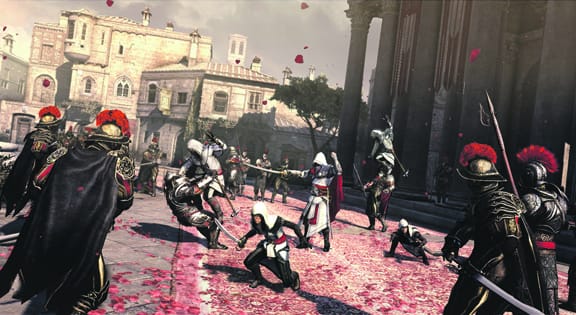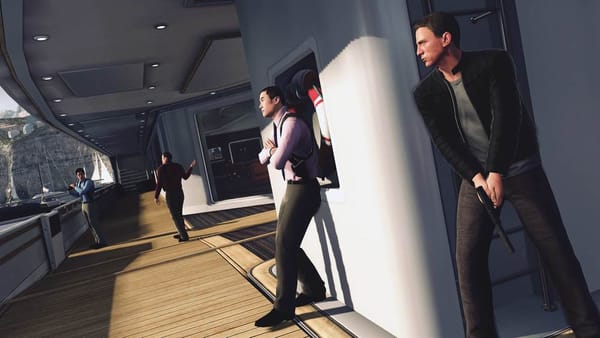When in Rome, do as the Assassins have always done
Which means, kick a whole lot of ass in Assassins Creed: Brotherhood

After having your mind completely blown by Assassin’s Creed II’s preposterous ending (spoiler), Brotherhood returns to connect the dots in the bizarre tale and explain what exactly is going on. But in doing so, does it bring any new and redeeming features to expand the series and is it worth it as a game in its own right?
At the core of the game remain the missions. These usually relate to tailing a target, scaling monstrous buildings to find an item, or – of course – assassinations. Unfortunately, as is almost expected, the missions really haven’t changed. It’s easy to see how the game is almost exactly the same as Assassin’s Creed II, merely with different scenery. Understandably it is difficult to design new features into such a winning formula, however, as with the previous games it’s easy to get bored by the repetitiveness of such quests. On the other hand, a good new feature is the ‘100% Synchronisation’ goal. This gives you a challenge to complete within the quest – for example you may have to kill only your target or finish the mission in a certain amount of time. This makes the missions a lot more interesting, but it can be a bit disappointing to know you’ve completed the mission and not achieved the challenge, and thus have only achieved ‘50% synchronisation’.
The game takes place in Rome, which is now under the rule of the Borgia family, who are associated with the Templars and at war with the Assassins. They have a vendetta against Ezio (the main character) who must work his way up, gaining a team in order to take down this family and their tyrannous rule of the city. The city is split up into twelve sections, each overlooked by a so-called ‘Borgia tower’. In order to restore Rome to its previous glory, Ezio must enter these towers, assassinate the captains and then burn down the towers. This allows you to then purchase the shops nearby and also open secret tunnels – a new quicker way of moving around the city. By doing this you access new equipment to unlock and also increase the income of money, much like improving Monteriggioni did in the previous game. The towers do not have to be destroyed but it makes doing missions in that area a lot easier – and it’s also a lot of fun.
Destroying the towers also makes way for a new concept; buying assassins guilds. These new guilds allow you to train assassins that join your team. This is certainly a very cool feature and is very entertaining, but it really detracts from the difficulty of the game. All you have to do is press a button and a team of six assassins jump in and kill all the guards near you, meaning you have to do nothing at all. This really is a bit of a double-edged blade in all honesty for, as amusing as it is watching your assassins fly in from nowhere and destroy your enemies, it really is like an infinite get-out-of-jail-free card. This is especially true when you consider that combat has never been difficult in this series.
Combat is once again dominated by long times of waiting for opponent attacks to simply press one button and counter and kill them immediately, with a few exceptions (including the new Borgia captains). This quickly becomes repetitive and really offers no challenge, with the only redeeming feature being the new combo animations – why just stab someone when you can also shoot them? It’s impossible not to enjoy the amusing scenes that show off your entire armoury.
Why just stab someone when you can also shoot them? It’s impossible not to enjoy the amusing scenes that show off your entire armoury
The newest and perhaps greatest feature by far of this game, is the multiplayer. There are four modes of play for multiplayer; Wanted, Advanced Wanted, Manhunt and Alliance. These are all variations on the central idea of hunting down a target whilst avoiding being hunted down, the trick being that there are many ‘civilian’ NPCs who look identical to your target. Killing these people will not get you points and will lose you your target. There is also a points system for the style of kill which really benefits true assassins, as by remaining stealthy and killing your target without them noticing you gain a lot more points than just running after them and alerting everyone to your presence. Wanted and Advanced Wanted are free-for-alls with there being a few tweaks in the rules for Advanced Wanted. For example, the tracking device is far less accurate making you have to look out for tell tale signs before deciding whom to assassinate in order not to accidentally kill a civilian. Manhunt consists of two teams of four assassins where one team hides whilst the other hunts. Teams gain more points for working together, as a team that is hiding close together will gain far more points than a team spread out across the map. Finally, Alliance pits four teams of two assassins against one another which again relies heavily on the team working together to track down their targets and again rewards those who work together.
In conclusion I would say that Assassin’s Creed: Brotherhood really is not that big a step up from the previous game. The gameplay is much the same, and if you’ve played the previous games it really doesn’t make much of a new impression. For newcomers to the series, this is a great start with both beautiful looks and missions that for the first few tries remain entertaining. The multiplayer is a great addition to the series and brings a much needed rejuvenation.
However, it alone does not prevent the sad fact that this game isn’t quite as revolutionary as it’s predecessors. If I were to be honest, I would tell you to wait until this game comes down in price and start on the multiplayer, as this is easily the greatest part of the game, but alone it’s not worth paying full price for.
Assassin's Creed: Brotherhood is available now for Xbox 360 and PS3, and will be available on PC in early 2011.








